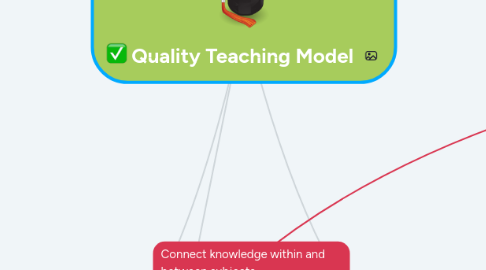
1. Quality Learning Environment
1.1. Explicit Quality Criteria
1.1.1. Define high and low quality performance
1.2. High-standards Expectations
1.2.1. Create challenging activities
1.2.2. Establish relationships
1.2.3. Build on learners strengths
1.2.4. Use broad range teaching stratgies
1.3. Academic Engagement
1.3.1. Involve the learners
1.3.2. Monitor progress and provide feedback
1.3.3. Foster confidence
1.4. Social Support for learner-achievement
1.4.1. Fosters
1.4.1.1. Collaboration
1.4.1.2. Success
1.4.1.3. Participation
1.5. Learner self-regulation
1.5.1. Set own goals
1.5.2. Deliberate learning strategies
1.5.3. Self-evaluate progress regularly
1.6. Learner choice
1.6.1. Encourage co-operative learning
1.6.2. Use research projects
2. Learning Significance
2.1. Background knowlegde
2.1.1. Determine / be aware of past knowledge
2.1.2. Build on past knowlegde
2.2. Knowledge Integration
2.2.1. Linking of subjects within and throughout
2.2.2. View as a set of ideas
2.3. Cultural Knowlegde
2.3.1. Awareness of/respect for different view
2.3.2. Use cultural related examples
2.4. Inclusiveness
2.4.1. Language
2.4.2. Participation
2.5. Narative
2.5.1. Relevant examples
2.5.2. Believable stories
2.5.3. Entertaining stories
2.6. Connectedness
2.6.1. Practical examples
2.6.2. Real-world experiences
2.6.3. Personal experiences
3. Intellectual Quality
3.1. Deep Understanding
3.1.1. Focus instruction on understanding and not memorisation
3.1.2. Give detail explanations
3.1.3. Encourage thinking / critical-thinking
3.1.4. Testing opportunities on understanding
3.2. Significant knowlegde
3.2.1. Concepts
3.2.2. Principles
3.2.2.1. Forming Web of connections
3.2.3. Central ideas
3.3. High-order thinking
3.3.1. Cognitive thinking that streches minds
3.3.2. Upper levels of acknowledge hierarchies of thinking
3.3.3. Processing through understanding / applying / analyzing / evaluating
3.3.4. Construct new ideas through interpreting / explaining / problem-solving / research
3.4. In-depth communication
3.4.1. Substantive communication
3.4.2. Debating / comparing / challenging / hypothesesing
3.4.3. Test and refine understanding
3.5. Language awareness
3.5.1. Metalanguage
3.5.2. Awareness and control over thinking
3.5.3. How language shapes and manipulate understanding
3.6. Conditional Knowledge
3.6.1. Questioning information, assumptions, perceptions, believes and the conditions.
3.6.2. Socially constructed ideas
3.6.3. Openness to different Interpretations
